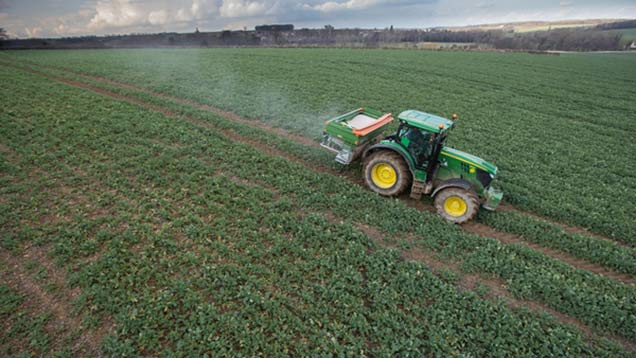How to manage soil-mapping data
 ©Tim Scrivener
©Tim Scrivener North Yorkshire grower Graham Potter is used to handling large amounts of data and relies on his management software to plan nutrient and seed inputs.
He has been variably applying P & K and lime for four years and nitrogen for three years on his 200ha of cropping in North Yorkshire, with first, second and third winter wheats, oilseed rape and fodder beet.
See also: Tips for getting the most out of cropping records
“We’ve just retested the fields and we have seen a real evening up of fields by not blanket applying at the standard rate in the past four years.”
Mr Potter is using the precision farming service Soyl to produce nutrient maps for P, K and lime while for nitrogen, it includes satellite imaging of canopy cover to allow rates to be adjusted in season.
Last year he went further by varying seed rates. “You can see rates vary from say 177kg/ha in poorer areas down to 127kg/ha in good parts of fields.”
This year Mr Potter is trialling variable rate plant growth regulators, initially on his oilseed rape, to even up fields.
“Using canopy imaging data, areas looking good will receive a PGR while backward areas will get N fertiliser,” he explains.
How it works
A Soyl programme generates the map of nutrient and seed rates in a field. “You then simply download it as a zip file and import into GateKeeper, which generates the jobs lists.
“Each October/November, I work out what is needed and put it on the system with the job lists for the following season for nitrogen, triple super phosphate (TSP) and muriate of potash (MOP).
“Amounts are calculated using Nutrient Management Plan on GateKeeper and Planet, tweaking the bits I need to.”
Then he exports the job plans to the John Deere GreenStar GPS system.
“Once you have completed the task, you export data back to GateKeeper and it records exact amounts of product used and the costs.
“Compatibility is essential and the key to both systems. It only takes five to 10 minutes from downloading the job from ‘My Soyl’ to GateKeeper then to GreenStar before the tractor and spreader/sprayer is ready to variably apply fertiliser.”
Benefits
“We have seen real cost savings. For example, we used to blanket apply TSP/MOP blend, but in one field alone, we have saved about £1,000 over the four years, as it only needed a small amount of TSP in one corner and field end.
He has also seen yield benefits. “Wheat yields were good last year with some crops at 13t/ha and the lowest on some heavy land was 7t/ha.”
The key to using GateKeeper is being able to look at your margin maps at the end of the year and overlay all your variable rate maps and yield maps to give you an accurate cost in each zone of the field.
“You can see where you are making money and where you are losing money, so you can do something about it to make things better.”
He concludes: “GateKeeper is a brilliant management tool for bringing your farm together.”
Get more from your crop records
Ben Hatton, key account manager, FarmPlan, gives his top tips.
Having a clear idea of what you are trying to achieve is key in getting the most out of crop records.
“Many see data handling software as a tool which you enter data into and magically the results come out,” says Ben Hatton. “But you need to look at it as a giant filing cabinet, and therefore, have a clear plan.”
The main reason many invest in farm records is to meet legal and farm assurance requirements, but some look to do more, such as cost analysis.
To help these farmers, GateKeeper has bolt-ons offering full budgeting, a pesticide decision support and handling data for precision farming.
More farmers are moving to precision farming and GateKeeper allows them to make use of the mapping data and variable fertiliser applications.
“A good example is when using yield map data. The raw data shows the variation in offtake across the field, which can be affected by in-field obstacles for example that may give a ‘skewed’ view on the performance at that location.
GateKeeper’s tools include the ability to ‘remove the noise’ so that the offtake maps become a practical reference.”
The next step is to understand what data you have and how accessible it is, says Mr Hatton.
“For example, is your agronomist using GateKeeper? If so, there are fewer barriers to data exchange and it cuts the leg work of standardising data.”
Finally, frequency of use is key. “It needs to be driven. If using it once quarter, you are not getting the most out of it. A little but often approach is best.”
GateKeeper manages all aspects of growing crops, including assurance, traceability, compliance and cost analysis. The software can be tailored to farm size, crop type and user access with options for handheld data recording, budgeting, precision farming and mapping. Go to www.farmplan.co.uk to find out more.

